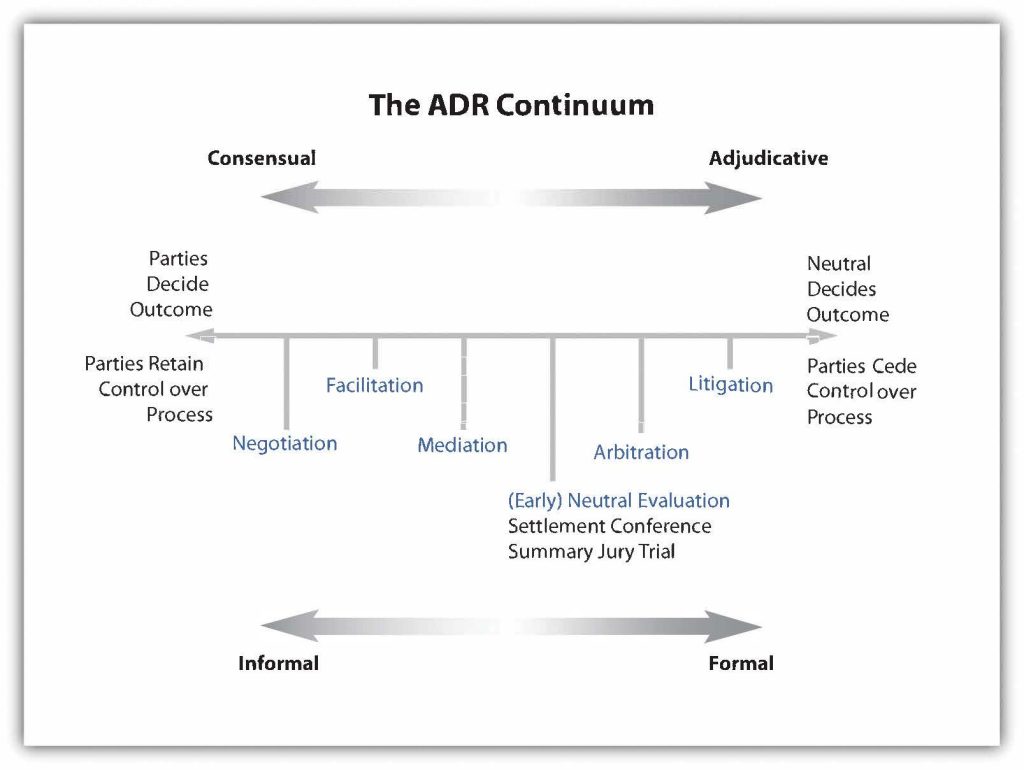Chapter 3 – Alternative Dispute Resolution
3.1 General Perspectives on Alternative Dispute Resolution
Imagine that you believe you’ve been wronged by a supplier, by your employer, or by a business where you are a customer. You’ve correctly determined that you have an actionable legal claim. But, now what do you do to try to resolve that claim? We learned in a prior chapter that one option might be to initiate a lawsuit against the alleged wrongdoer. But you know that litigation is expensive and time consuming, not to mention frustrating. If you want to try to continue to have a relationship with a supplier, employer, or other business, filing a lawsuit against them is unlikely to promote a strong current and future business relationship. If the matter is of a private nature you may not want to engage in a public process to determine the outcome. So, while you want the matter to be addressed and resolved, you may not want to engage in public, time-consuming, expensive and adversarial litigation to resolve it.
A common method of dispute resolution that avoids many of the challenges associated with litigation is alternative dispute resolution. Alternative dispute resolution (ADR) is a term that encompasses many different methods of dispute resolution other than litigation. ADR involves resolving disputes outside of the judicial process, though the judiciary can require parties to participate in specific types of ADR, such as arbitration, for some types of conflicts. Moreover, some ADR methods vest the power to resolve the dispute in a neutral party, while other strategies vest that power in the parties themselves. See Figure 3.1 “A Continuum of Different ADR Methods” to understand ADR methods based on where the power to solve the dispute is vested.
Figure 3.1 A Continuum of Different ADR Methods

Source: Adapted from New York State Unified Court System
Common methods of ADR include negotiation, mediation, and arbitration. Less frequently used methods of ADR include minitrials, hybrid forms of mediation-arbitration (with elements of both), and collaborative goal-oriented processes. ADR is often used to resolve disputes between businesses, employers and employees, and businesses and consumers. ADR can also be used in many other types of conflicts. For instance, ADR strategies can be used in domestic law cases, such as divorce, or in international legal issues, such as issues relating to transboundary pollution. This Chapter focuses on the use of common ADR methods in business, including the benefits and drawbacks to each. We will also examine potential consequences to parties that have unequal bargaining power. Additionally, we will examine the use of ADR methods in situations where ADR may not be the most appropriate method of dispute resolution, such as civil rights violations.
ADR methods are used outside of the courtroom, but that does not mean that they are outside of the interests of our legal system. Participation in ADR has important legal consequences. For instance, parties that have agreed by contract to be subject to binding arbitration give up their constitutional right to bring their complaint to court. The Federal Arbitration Act (FAA) is a federal statute under which parties are required to participate in arbitration when they have agreed by contract to do so, even in state court matters. Indeed, the FAA is a national policy favoring arbitration. In New Jersey, there are certain types of cases filed with courts that are required to go first to mandatory arbitration. This court-ordered arbitration would be non-binding because it was ordered by a court, yet this court rule showcases the policy of the state to try to use ADR to resolve disputes between parties.
It is likely that you will or already have agreed to a contract that contains a mandatory arbitration clause. Arbitration clauses are common in business contracts, consumer contracts, and even employee handbooks. If a dispute arises under that contract or agreement, you will be required to arbitrate your claim rather than going straight to court. Under a binding arbitration clause, you will have waived your constitutional rights to go to court. Because of this, it’s important to understand the ADR process, situations in which litigation is a better choice than ADR, and special issues that arise when parties have unequal bargaining power.
a catchall term that describes a variety of methods that parties can use to resolve disputes outside of court, including negotiation, conciliation, mediation, collaborative practice, and the many types of arbitration
an out-of-court procedure for resolving disputes in which one or more people -- the arbitrator(s) -- hear evidence and make a decision
a give-and-take discussion that attempts to reach an agreement or settle a dispute
a process that involves opposing parties in a dispute meeting with a neutral third party (called the "mediator") who helps them negotiate a resolution outside of court
a procedure that allows the parties to present their case to decision makers on both sides of the dispute, following discovery
a mediation followed by an arbitration when the mediation does not produce a satisfactory outcome
a federal statute under which parties are required to participate in arbitration when they have agreed by contract to do so, even in state court matters
mandatory referral of a certain class of civil suits to an arbitration hearing

